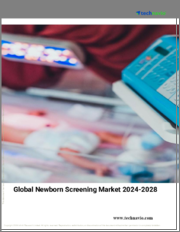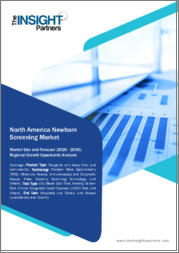
|
시장보고서
상품코드
1429227
세계의 신생아 스크리닝 : 시장 점유율 분석, 산업 동향 및 통계, 성장 동향 예측(2024-2029년)Global Newborn Screening - Market Share Analysis, Industry Trends & Statistics, Growth Forecasts (2024 - 2029) |
||||||
세계의 신생아 스크리닝 시장 규모는 2024년에 12억 9,000만 달러로 추정되고, 2029년에는 19억 7,000만 달러에 이를 것으로 예측되며, 예측 기간(2024-2029년)의 CAGR은 8.90%로 성장할 전망입니다.

COVID-19 팬데믹은 SARS-COV-2 바이러스의 높은 감염률로 인한 COVID-19 환자의 대량 유입으로 세계 건강 관리 시스템의 모든 측면에 영향을 미쳤습니다. 또한 COVID-19 관리에 자원이 사용되었기 때문에 신생아 스크리닝 절차도 처음에는 영향을 받았지만 이는 시장에 영향을 미칠 것으로 예상되었습니다. 예를 들어, 2022년 3월에 발표된 'Global impact of COVID-19 on newborn screening programs(신생아 스크리닝 프로그램에 대한 COVID-19의 세계적 영향)'라는 제목의 조사 연구에 따르면, 대부분의 신생아 스크리닝 센터는 팬데믹의 영향은 거의 없었습니다(47.7%), 중간 정도의 영향이 있었습니다(18.6%), 큰 영향이 있었습니다(12.8%)라고 회답했지만, 16.3%의 센터는 영향이 없었다고 회답했습니다. 또한 같은 출처에 따르면, 회답한 38개국 중 29개국에서 COVID-19는 신생아 스크리닝 프로그램에 어떤 영향을 미치며, 대부분의 스크리닝 센터가 다양한 문제를 겪었으며 대부분은 팬데믹의 제2파에 의해 부정적인 영향을 받았습니다. 따라서 COVID-19는 신생아 스크리닝 시장에 큰 영향을 미친 것으로 평가됩니다.
신생아 스크리닝 시장의 성장 요인으로는 신생아 스크리닝 프로그램의 확대, 선천성 질환의 발생률 증가, 신생아 스크리닝을 위한 정부 부문의 자금 조달, 신생아 스크리닝에 사용되는 기술의 발전 등이 있습니다. 예를 들면, 2022년 4월에 발표된 「Epidemiology of Congenital Heart Disease in Jinan, China From 2005 to 2020(중국 제남시에서 선천성 심장 질환의 역학, 2005년부터 2020년까지)」라고 제목이 붙은 조사 연구에 따르면 중국 제남시에서는 선천성 심장 질환의 발생률이 증가하고 있습니다. 선천성 심질환(CHD)의 유병률은 출생 1,000명당 4.81명이었지만, 농촌에서는 3.17명이며, 2005년부터 2020년에 걸쳐, CHD의 유병률은 도시에서 157.45%, 시골 지역에서 316.03% 각각 증가했습니다. 마찬가지로 세계보건기구(WHO)의 2022년 2월 데이터(추정)에 따르면 출생시의 이상은 세계에서 매년 생후 28일간 약 24만명의 신생아 사망의 원인이 되고 있습니다. 게다가 생후 1개월부터 5세까지 17만명의 아이가 출생시 이상으로 사망하고 있습니다. 따라서 신생아 스크리닝은 신생아의 다양한 선천적 이상과 질병을 결정할 때 신생아의 적절한 건강 분석을 제공할 수 있으며 신생아에게 적절한 의료 조치를 제공하고 신생아의 생명을 구하기 위해 사용할 수 있기 때문에 매우 중요합니다. 그러므로 신생아 스크리닝에 대한 수요는 증가할 것으로 예상되며 예측 기간 동안 조사 시장의 성장을 가속합니다.
또한 일부 정부가 퇴원 전 신생아 스크리닝을 의무화하고 있기 때문에 대륙 각지의 정부가 운영하는 신생아 스크리닝 프로그램은 신생아 스크리닝 시장의 성장에 큰 영향을 미칠 것으로 예상됩니다. 예를 들어, 2021년 March of Dimes(MoD)의 보고서에 따르면, 미국에서는 퇴원 전에 모든 아기가 신생아 선별검사를 받고 있으며 매년 약 400만 명의 신생아를 선별합니다. 또한 신생아 스크리닝 플랫폼과 장치의 기술적 진보는 예측 기간에 걸쳐 신생아 스크리닝 시장에 큰 긍정적인 영향을 미칠 것으로 예상됩니다. 그러나 신생아 스크리닝 정책과 절차가 세계적으로 통일되지 않은 것, 검사에 의한 위양성과 위음성의 결과가 많은 것 등이 예측 기간 중 신생아 스크리닝 시장을 억제할 것으로 예상됩니다.
신생아 스크리닝 시장 동향
예측 기간 동안 건조 혈액 스팟 부문이 시장의 주요 점유율을 차지할 전망
COVID-19의 팬데믹은 DBS 신생아 스크리닝 검사에 대한 대규모 수요를 만들어 팬데믹 중 신규 NBS 검사의 개발로 이어졌습니다. 2020년 7월 PerkinElmer Inc.는 GSP/DELFIA 플랫폼을 이용한 SARS-CoV-2 IgG의 드라이브 래드 스팟(DBS) 기반 검사를 출시하여 하루에 최대 5,000개 시료를 처리할 수 있게 되었습니다. DBS 분석은 파킨 엘머의 GSP 분석기에서 수행되며, DELFIA 플랫폼의 범용 TRF(시간 분해 형광)와 결합하여 32개국에 걸쳐 세계 신생아의 30% 이상을 스크리닝합니다.
건조 혈액 스팟 검사(DBS)는 예측 기간 동안에도 우위를 유지할 것으로 예상됩니다. DBS 샘플링은 50년 이상 신생아 선천성 대사 질환의 스크리닝에 사용되어 왔습니다. DBS 샘플링의 이점은 필요한 양이 최소이며(스폿 당 약 30-100 l), 손가락 또는 발 뒤꿈치 스틱으로 샘플을 채취하기 쉽고 필요한 교육을 최소화하며 운송하기 쉽고 샘플이 안정되는 등이 있습니다. 자폐증, 림프종, 백혈병 및 기타 많은 대사성 질환을 이 검사로 진단할 수 있습니다. 건조 혈액 스폿 분석은 소량의 샘플을 채취하고 쉽게 운반할 수 있다는 장점이 있습니다. 따라서 신생아의 질병 증가는 시장 성장을 뒷받침하고 있습니다.
또한, 이 부문은 기존 제품에 대응하기 위해 새로운 제품과 기술을 개발하는 조직과 학술 기관이 있습니다. 예를 들어, 2022년 3월, 옥스포드 대학은 템스 강 유역에서 집단 기반 신생아 스크리닝 연구를 시작했습니다. 이 스크리닝은 신생아의 Guthrie 카드(건조 혈액 스폿 샘플)의 예비 용량을 사용하고 영국의 일상 신생아 혈액 스팟 스크리닝 경로를 통해 이루어집니다. 따라서 위의 요인은 예측 기간 동안 연구 부문의 성장을 가속할 것으로 예상됩니다.

예측 기간 동안 북미가 시장의 주요 점유율을 차지할 전망
북미는 동지역에서 선천성 결손증이 높은 부담, 정부 정책, 견고한 헬스케어 인프라의 존재, 이 지역을 거점으로 하는 기업에 의한 신생아 스크리닝 기술의 새로운 기술 개척 등에 의해 신생아 스크리닝 시장에서 큰 점유율을 차지할 것으로 예상됩니다. 예를 들어, 2022년 4월에 발표된 「14세 이전의 아이의 사망률과 선천성 이상의 관련」이라고 표기된 조사 연구에 의하면, 선천성 이상은 순환기, 호흡기, 소화기계의 원인에 의한 사망률과 강하게 관련되어 있으며, 이 발견은 사망률에 있어서 선천성 이상의 역할이 과소평가되고 있을 가능성을 제기하고 있습니다. 이 연구는 캐나다에서 실시된 것으로, 같은 정보원에 의하면, 심장 질환, 염색체 이상, 중추 신경계 장애 등의 선천성 이상은 모두, 사망 가능성을 각각 10배 이상, 8배 이상, 17배 이상 증가하여 사망 위험은 생후 28일부터 364일 사이에 유의미하게 높았으나 다른 시기에도 높았습니다. 따라서 이 지역의 신생아 선별 수요는 시간이 지남에 따라 증가하고 이 지역 시장은 성장할 것으로 예상됩니다.
북미에서는 미국이 가장 큰 시장 점유율을 차지할 것으로 예상됩니다. 이것은 신생아의 장애 발생률이 증가하고 있으며 고급 시스템에 대한 수요가 증가하고 있기 때문입니다. 미국에서는 모든 신생아가 출생 후 스크리닝을 받고, 이 스크리닝은 생후 2일째에 여과지에 채취한 혈액 스폿의 진단 마커를 분석함으로써 실시됩니다. 미국에서는 신생아 스크리닝 프로그램이 주 단위로 실시되고 있기 때문에 많은 주의 검사 패널에 통일성이 없는 것이 관찰되고 있습니다. 예를 들어 미국 질병예방관리센터가 발표한 데이터에 따르면 2022년 국내 신생아 출생수는 약 3,613,647명, 2022년 국내 출생률은 인구 1,000명당 11.0명으로, 대부분 병원에서 출생하고 있기 때문에 스크리닝은 퇴원 전에 실시됩니다. 또한 이 지역에서의 새로운 서비스와 제품 출시는 조사한 시장 성장에 큰 영향을 미칠 것으로 예상됩니다. 예를 들어, 2021년 6월, 텍사스 주 보건 복지국은 척수성 근위축증(SMA)의 신생아 스크리닝을 시작했습니다. 따라서, 상기 요인들로부터 신생아 스크리닝 시장은 예측 기간 동안 큰 시장 점유율을 획득할 것으로 예상됩니다.

신생아 스크리닝 업계 개요
신생아 스크리닝 시장의 경쟁은 중간 정도이며 여러 선도 기업으로 구성됩니다. 시장 점유율 측면에서 현재 시장을 독점하는 주요 기업은 소수입니다. 시장의 주요 기업로는 Agilent Technologies Inc., Natus Medical Inc., Trivitron 헬스케어, Medtronic Inc., Masimo Corp., Bio-Rad Laboratories Inc. 등이 있습니다.
기타 혜택 :
- 엑셀 형식 시장 예측(ME) 시트
- 3개월간의 애널리스트 서포트
목차
제1장 서론
- 조사의 전제 조건 및 시장 정의
- 조사 범위
제2장 조사 방법
제3장 주요 요약
제4장 시장 역학
- 시장 개요
- 시장 성장 촉진요인
- 선천성 질환의 부담 증가
- 신생아 스크리닝을 위한 정부 부문으로부터의 자금 증가
- 신생아 스크리닝에 사용되는 기술의 진보
- 시장 성장 억제요인
- 세계 각국에 있어서의 신생아 스크리닝의 방침과 순서의 통일성 부족
- 위양성 및 위음성의 결과
- Porter's Five Forces 분석
- 구매자 및 소비자의 협상력
- 공급기업의 협상력
- 신규 참가업체의 위협
- 대체품의 위협
- 경쟁 기업간 경쟁 관계의 강도
제5장 시장 세분화
- 기술별
- 탠덤 질량 분석
- 펄스 옥시메트리
- 효소 기반 분석
- DNA 분석
- 기타 기술
- 검사 유형별
- 건조 혈액 스폿
- 청각 스크리닝
- 중증 선천성 심장 질환(CCHD)
- 기타 검사 유형
- 최종 사용자별
- 병원
- 진단센터
- 기타 최종 사용자
- 지역별
- 북미
- 미국
- 캐나다
- 멕시코
- 유럽
- 독일
- 영국
- 프랑스
- 이탈리아
- 스페인
- 기타 유럽
- 아시아태평양
- 중국
- 일본
- 인도
- 호주
- 한국
- 기타 아시아태평양
- 중동 및 아프리카
- GCC
- 남아프리카
- 기타 중동 및 아프리카
- 남미
- 브라질
- 아르헨티나
- 기타 남미
- 북미
제6장 경쟁 구도
- 기업 프로파일
- AB Sciex
- Bio-Rad Laboratories Inc.
- GE Healthcare
- Masimo Corporation
- Medtronic Inc.
- Natus Medical Incorporated
- PerkinElmer Inc.
- Trivitron Healthcare
- ZenTech SA
- Demant A/S
- Waters Corporation
- Thermo Fisher Scientific
- Hill-Rom Holdings Inc.
제7장 시장 기회 및 앞으로의 동향
AJY 24.02.28The Global Newborn Screening Market size is estimated at USD 1.29 billion in 2024, and is expected to reach USD 1.97 billion by 2029, growing at a CAGR of 8.90% during the forecast period (2024-2029).
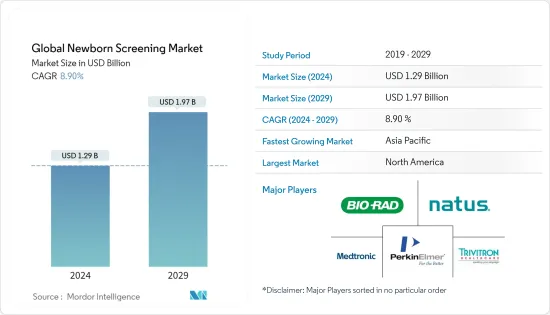
The COVID-19 pandemic affected every aspect of the healthcare system around the world due to the high influx of COVID-19 patients owing to the high infectivity rate of the SARS-COV-2 virus. The newborn screening procedures were also impacted initially due to the diversion of resources towards COVID-19 management which is anticipated to have an impact on the market. For instance, according to a research study titled 'Global impact of COVID-19 on newborn screening programs' published in March 2022, most newborn screening centers responded that the pandemic created little effect (47.7%), 18.6% a moderate effect, and 12.8% a lot, while 16.3% of the centers reported no effect. Also, as per the same source, in 29 of the 38 countries that responded, COVID-19 had some effect on the newborn screening programs and most of the screening centers encountered a wide range of issues, and the majority were more negatively impacted by the pandemic's second wave. Hence, COVID-19 is expected to have a significant impact on the newborn screening market.
Factors responsible for the growth of the newborn screening market include growing newborn screening programs, rising incidences of congenital diseases, raising funding from government sectors for newborn screening, and advancements in technologies used in newborn screening. For instance, according to a research study published in April 2022, titled 'Epidemiology of Congenital Heart Disease in Jinan, China From 2005 to 2020: A Time Trend Analysis', in urban regions, the prevalence of congenital heart disease (CHD) was 4.81 per 1,000 births from 2005 to 2020, compared to 3.17 per 1,000 births in rural areas and the prevalence of CHD grew by 157.45% and 316.03%, respectively, in urban and rural areas between 2005 and 2020, according to a time trend analysis of the data. Similarly, according to the February 2022 data of the World Health Organization, an estimate, birth abnormalities are responsible for the death of about 240,000 newborns in the first 28 days of life each year across the glove and an additional 170,000 children between the ages of 1 month and 5 years die because of birth abnormalities. Hence, newborn screening becomes very important as it can provide a proper health analysis of newborns in determining various birth defects or diseases, which can be used to provide adequate medical attention to the newborn and save the life of the newborn. Thus, the demand for newborn screening is expected to increase which will fuel growth in the studied market over the forecast period.
Further, the newborn screening programs run by governments across the continent are expected to have a significant impact on the growth of the newborn screening market as several governments have made newborn screening compulsory before getting discharged from the hospital. For instance, according to the March of Dimes (MoD) report of 2021, before leaving the hospital, every baby in the United States receives newborn screening and the nation screens around 4 million newborns annually. Moreover, the technological advancement in newborn screening platforms and devices is also expected to have a significant positive impact on the newborn screening market over the forecast period. However, the lack of uniformity in newborn screening policies and procedures across the world, and a high number of false positive and false negative results from the tests are expected to restrain the newborn screening market during the forecast period.
Newborn Screening Market Trends
Dried Blood Spot Segment is Expected to Hold the Major Share in the Market Over the Forecast Period
The COVID-19 pandemic has created a massive demand for DBS newborn screening tests, which has led to the development of novel NBS tests during the pandemic. In July 2020, PerkinElmer Inc. launched a dry blood spot (DBS) based test for SARS-CoV-2 IgG using its GSP/DELFIA platform, enabling the processing of up to 5,000 samples per day. The DBS assay runs on PerkinElmer's GSP analyzer and, combined with the universal TRF (time-resolved fluorescence) of the DELFIA platform, screens more than 30% of all newborn babies worldwide, spanning 32 countries.
Dried blood spot tests (DBS) are expected to continue their domination during the forecast period. DBS sampling has been used to screen newborn babies for congenital metabolic diseases for over 50 years. The advantages of DBS sampling include minimal volume requirements (approximately 30 - 100 μL per spot), ease of sample attainment by finger or heel stick with minimal training required, and ease of transport and sample stability. Autism, lymphomas, leukemia, and many other metabolic conditions can be diagnosed through this test. Dried blood spot analysis offers the advantage of collecting a small sample volume, which can be easily transported. Thus, rising diseases in newborns are boosting market growth.
Additionally, few organizations and Academic institutes in the segment have been developing novel products and technologies to compete with the existing products. For instance, in March 2022, Oxford University initiated a population-based newborn screening study in the Thames valley. The screening will be done through the routine United Kingdom newborn blood spot screening pathway, using spare capacity from a newborn's Guthrie card (dried blood spot sample). Thus the factors mentioned above are expected to drive the growth of the studied segment during the forecast period.
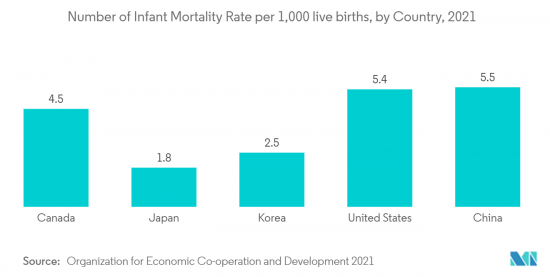
North America Region is Expected Occupy Major Share in the Market Over the Forecast Period
The North American region is expected to hold a major share in the newborn screening market owing to the high burden of birth defects in the region, government policies, the presence of robust healthcare infrastructure, and new technological developments in newborn screening technology by the players based in the region. For instance, according to a research study published in April 2022, titled 'Association of Birth Defects with Child Mortality Before Age 14 Years', birth defects were strongly associated with mortality owing to circulatory, respiratory, and digestive causes and the finding raises the possibility that the role of birth abnormalities in mortality numbers may be understated. The study was conducted in Canada and as per the same source, birth defects such as heart problems, chromosomal anomalies, and central nervous system disorders all increased the chance of death by more than ten times, eight times, and seventeen times, respectively, and the risk of death was significantly higher between days 28 and 364 of life, however, it was also higher at other times. Hence the demand for newborn screening in the region is expected to increase over time and the market is expected to grow in the region.
In the North American region, the United States is anticipated to hold the largest market share. This can be attributed to the increasing incidence rates of disorders in newborns and the rising demand for advanced systems. In the United States, every newborn is screened post-birth, and this screening is performed by the analysis of diagnostic markers in blood spots collected on filter paper on the second day of an infant's life. Newborn screening programs are run on a state basis within the United States; therefore, it has been observed that there is a lack of uniformity among the testing panels of many states. For instance, according to the data published by the Centers for Disease Control and Prevention, in 2022, about 3,613,647 new births were reported in the country, and the birth rate in the country 2022 was 11.0 per 1,000 population, and most of these birth in hospitals, thus, the screening is performed before babies' discharge. Further, the launch of new services and products in the region is expected to have a significant impact on the growth of the studied market. For instance, in June 2021, the Texas Health and Human Services launched newborn screening for Spinal Muscular Atrophy (SMA). Therefore, due to the above-mentioned factors, the newborn screening market is expected to have a significant market share over the forecast period.
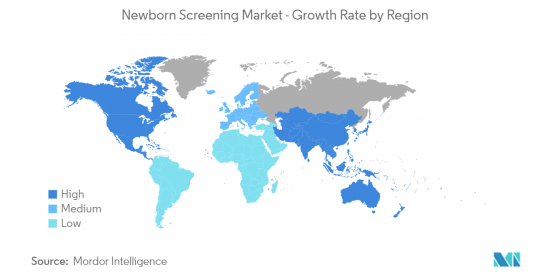
Newborn Screening Industry Overview
The newborn screening market is moderately competitive and consists of several major players. In terms of market share, few of the major players currently dominate the market. Some of the of key players in the market are Agilent Technologies Inc., Natus Medical Inc., Trivitron Healthcare, Medtronic Inc., Masimo Corp., and Bio-Rad Laboratories Inc., among others.
Additional Benefits:
- The market estimate (ME) sheet in Excel format
- 3 months of analyst support
TABLE OF CONTENTS
1 INTRODUCTION
- 1.1 Study Assumptions and Market Definition
- 1.2 Scope of the Study
2 RESEARCH METHODOLOGY
3 EXECUTIVE SUMMARY
4 MARKET DYNAMICS
- 4.1 Market Overview
- 4.2 Market Drivers
- 4.2.1 Rising Burden of Congenital Diseases
- 4.2.2 Rising Funding from Government Sectors for Newborn Screening
- 4.2.3 Advancements in Technologies Used in Newborn Screening
- 4.3 Market Restraints
- 4.3.1 Lack of Uniformity of Newborn Screening Policies and Procedures Across the World
- 4.3.2 False Positive and False Negative Results
- 4.4 Porter's Five Forces Analysis
- 4.4.1 Bargaining Power of Buyers/Consumers
- 4.4.2 Bargaining Power of Suppliers
- 4.4.3 Threat of New Entrants
- 4.4.4 Threat of Substitute Products
- 4.4.5 Intensity of Competitive Rivalry
5 MARKET SEGMENTATION
- 5.1 By Technology
- 5.1.1 Tandem Mass Spectrometry
- 5.1.2 Pulse Oximetry
- 5.1.3 Enzyme Based Assays
- 5.1.4 DNA Assays
- 5.1.5 Other Technologies
- 5.2 By Test Type
- 5.2.1 Dried Blood Spot
- 5.2.2 Hearing Screening
- 5.2.3 Critical Congenital Heart Defect (CCHD)
- 5.2.4 Other Test Types
- 5.3 By End User
- 5.3.1 Hospitals
- 5.3.2 Diagnostic Centers
- 5.3.3 Other End Users
- 5.4 Geography
- 5.4.1 North America
- 5.4.1.1 United States
- 5.4.1.2 Canada
- 5.4.1.3 Mexico
- 5.4.2 Europe
- 5.4.2.1 Germany
- 5.4.2.2 United Kingdom
- 5.4.2.3 France
- 5.4.2.4 Italy
- 5.4.2.5 Spain
- 5.4.2.6 Rest of Europe
- 5.4.3 Asia-Pacific
- 5.4.3.1 China
- 5.4.3.2 Japan
- 5.4.3.3 India
- 5.4.3.4 Australia
- 5.4.3.5 South Korea
- 5.4.3.6 Rest of Asia-Pacific
- 5.4.4 Middle East and Africa
- 5.4.4.1 GCC
- 5.4.4.2 South Africa
- 5.4.4.3 Rest of Middle East and Africa
- 5.4.5 South America
- 5.4.5.1 Brazil
- 5.4.5.2 Argentina
- 5.4.5.3 Rest of South America
- 5.4.1 North America
6 COMPETITIVE LANDSCAPE
- 6.1 Company Profiles
- 6.1.1 AB Sciex
- 6.1.2 Bio-Rad Laboratories Inc.
- 6.1.3 GE Healthcare
- 6.1.4 Masimo Corporation
- 6.1.5 Medtronic Inc.
- 6.1.6 Natus Medical Incorporated
- 6.1.7 PerkinElmer Inc.
- 6.1.8 Trivitron Healthcare
- 6.1.9 ZenTech SA
- 6.1.10 Demant A/S
- 6.1.11 Waters Corporation
- 6.1.12 Thermo Fisher Scientific
- 6.1.13 Hill-Rom Holdings Inc.






